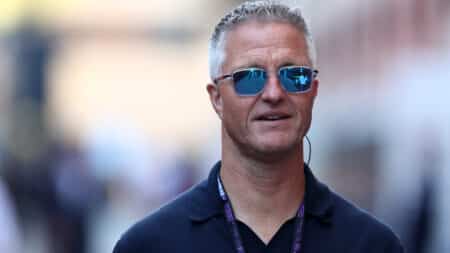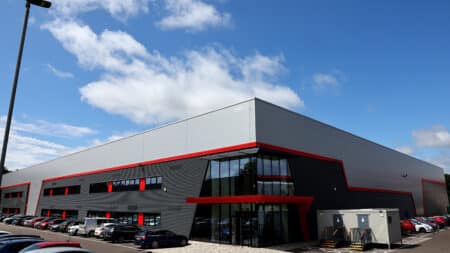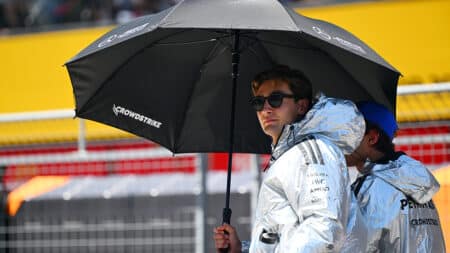
'Not even the best F1 driver in his family' - Pain of being the other Schumacher
He has always been overshadowed by his older brother but Ralf Schumacher’s 50-year story is more layered, and more human, than the stats alone suggest, says Matt Bishop
Professional racing drivers tend to fight shy of admitting to a favourite circuit because any such pronouncement presupposes that there are tracks where they might find themselves unable to give of their best. But would José Froilán González have flown from his native Argentina for a one-off outing with Vanwall had the race in question not been at Silverstone? Or indeed would team ‘Guv’nor’ Tony Vandervell have considered making the call otherwise?
The answer in both cases is probably not.
The 1956 British Grand Prix provided a perfunctory denouement to the unusual love story between ‘The Wild Bull of the Pampas’ and a former WWII bomber base. Having qualified a commendable sixth, on the same time as team-mate Harry Schell, González’ race lasted fewer than 100 yards because of a sheared driveshaft UJ. There is a photo of his sizeable rump slumped on his Vanwall’s sizeable slumped rump that speaks grumpy volumes.
Silverstone’s perimeter road, with its gentle undulations, constant-radius corners and wide-open spaces, provided the template for the modern GP circuit. It also provided the leeway necessary to absorb the excesses of an as-yet-untamed González on his day of days, but ultimately it taught him that Ascari/Clark-like accuracy and consistency were the skeleton keys to success.
His victory – the first for Ferrari at World Championship level – in the 1951 British GP has been mythologised more than most; his pre-race muttering and pacing; his bulging biceps and tummy jutting and spilling from the 375’s cockpit; his nervy pit stop and team-mate Alberto Ascari’s calming hand upon his shoulder. There can be no doubt that his performance in a theoretically slower 12-plug car caught the imagination – even Ascari, who had taken over González’ car to finish second at the preceding French GP, stood agog and aside on this occasion. It’s also true that González biffed some marker barrels at Stowe on his way to pole position and subsequently victory, and that he weaved in and out of some straw bales at Becketts while chasing the leading Alfa Romeo of his more stylish countryman Juan Manuel Fangio. But not every one of his 90 laps was spent on the ragged edge. Not every one of those 162 minutes was spent at the tattered fringes of nervous exhaustion. The moments that are remembered occlude the overriding abundance of skill and control. González was much was fitter – physically and mentally – than he looked. His chances of winning would have been slim in the extreme otherwise; certainly he never would have beaten Fangio in a straight fight.
Their boots were on the other’s feet at Silverstone three years later: it was Fangio who biffed the barrels and González who was the epitome of style. The latter’s defeat of the sensational streamlined Mercedes-Benz W196s was the last of his two World Championship GP victories. He qualified second behind Fangio, who mustered a do-or-die lap in practice, but led throughout, his Ferrari 625 rarely out of shape despite an oil-slicked surface and changeable weather conditions: same track – bar re-sited pits and start/finish line – but a very different performance.
This came a month after his stellar win at Le Mans, where in atrocious conditions his 375 Plus blunderbuss beat Jaguar’s sniper’s rifle D-type. González had given ample warning in the same car and in similar conditions at Silverstone in May by winning the sports car support race. He also won that meeting’s BRDC International Trophy despite having to swap from Ferrari’s new 553 Squalo to a rehashed 625 moments before the Final. At no stage, however, was “his new-found steady style” ruffled.
In between times, his Maserati GP car not yet ready, he had driven a BRM V16 “like an atom bomb” in the Formule Libre encounter at the 1952 British GP meeting – crashing one, commandeering another using a mix of tongues that required no translation, and exploding its gearbox in an overexcited chase of Piero Taruffi in Vandervell’s ‘Thinwall Special’. He had also charged hard, probably on half tanks, in the early stages of the 1953 British GP, only for his hassling of Ascari’s leading Ferrari to be stymied when his Maserati A6GCM was black-flagged for allegedly misting oil from its back axle; eventually he finished a vexed third, two laps in arrears.
In all bar the 1951 British GP he set or shared the race’s fastest lap. There is more than one way to skin a cat. Particularly once you’ve fractured vertebrae, which González did in crashing his Lancia D23 sports-racer during practice at Lisbon’s Monsanto Park in July 1953; his best time that day remained good enough for a theoretical pole position.
Ironically he was in a very different place as a racing driver when his mainstream career was ‘ended’ by an arm injury sustained in practice at Dundrod’s 1954 RAC Tourist Trophy. He was only 32 – Fangio was 11 years older – when he decided thereafter to concentrate on the running of his family’s car dealership.
González contested his home GP from 1955-’57 and finally in 1960, but only once did he race again overseas: at his beloved Silverstone, the track to which he owed his everlasting fame, and at which he honed his craft, completed his motor racing education and, to all intents and purposes, ended his GP journey.
Click here for more on Formula 1.

He has always been overshadowed by his older brother but Ralf Schumacher’s 50-year story is more layered, and more human, than the stats alone suggest, says Matt Bishop

Cadillac's Formula 1 entry was approved just 364 days before its first grand prix weekend. We took a look inside its Silverstone base to find out how it's building a brand new team from scratch

Describing this year's championship race as a 'battle' might be slightly over-egging it, writes James Elson

You had to read between the lines at the 2025 Austrian Grand Prix as George Russell dropped hints over about his dissatisfaction, and F1 sent a message to FIA president Mohammed Ben Sulayem